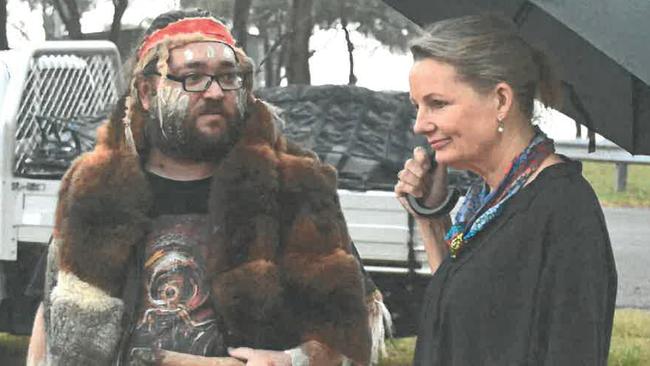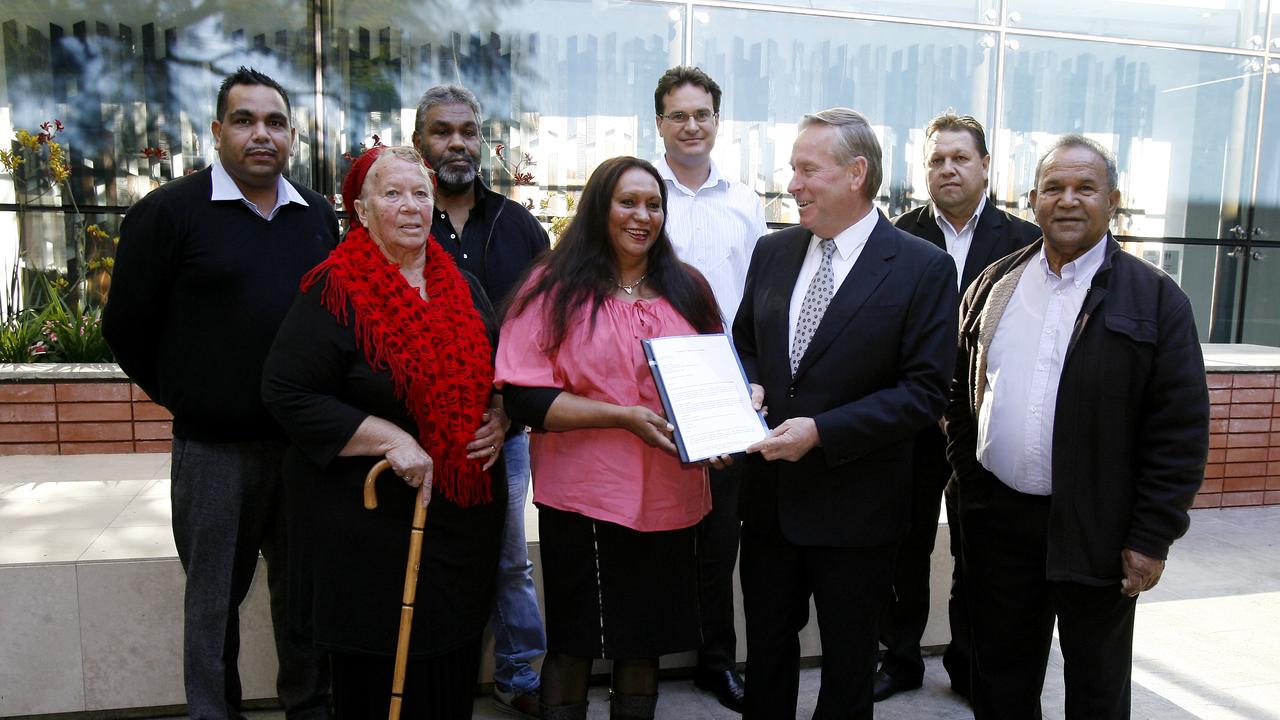Morrison government followed ‘song and dance’ of rebel Indigenous group
Indigenous land groups have alleged a heritage decision by Coalition minister Sussan Ley sparked ‘lateral violence’ and diminished their cultural authority, setting the path for the Blayney decision.

When former Liberal environment minister Sussan Ley blocked a Bathurst go-kart track for years, she was hoodwinked by the same fringe Indigenous group that duped her Labor successor Tanya Plibersek into shutting down the $1bn Blayney mine project, say Indigenous leaders.
Since vetoing the tailings dam site for the gold mine proposal, Ms Plibersek has justified her reliance on the advice of the rebel Wiradyuri Traditional Owners Central West Aboriginal Corporation by pointing to Ms Ley’s decision to block the Mt Panorama/Wahluu go-kart track proposal “for very similar reasons”.
But on Wednesday, a major convention of Local Aboriginal Land Council leaders in Orange was told Ms Ley, now Deputy Opposition Leader, had paved the way for the erosion of their authority.
The land council leaders criticised the appropriation of the Three Brothers Dreaming to block both the Mount Panorama track and the Blayney mine, pointing out that members of the rebel Wiradyuri Corporation were not the designated keepers of that dreaming.
The go-kart track area had “no Aboriginal heritage whatsoever” and the WTOCWAC at that point had just four members, according to Bathurst Local Aboriginal Land Council chief executive Toni-Lee Scott.
In her first public remarks on the controversy, Ms Scott said Ms Ley had taken “our cultural authority and given it to these wannabe fellas”.
“Council and the go-kart committee went through all the necessary requirements: environmentalists, archaeologists,” Ms Scott said. “We sent out our Aboriginal heritage officers to do site assessments on this particular site. This site potentially was an old clay-shooting pigeon range. And what had come back was that the site had no Aboriginal heritage whatsoever.”

“Then, bam, the Bathurst group (the WTOCWAC), who consisted of probably four people at that time (turned up). Their story was that that actual site was a women’s site, which was about 20 metres away from a men’s initiation site that they claimed was there. (But) we’re talking about a site 700 or 800m above sea level. Now what women’s site do we know of that’s not near water? I don’t know any.”
Ms Scott said she had no experience at the time of navigating a Section 10 consultation process and had to rely on the advice of Orange Local Aboriginal Land Council chief executive Annette Steele, who would soon become embroiled in her own dispute with the WTOCWAC.
“Back then, our minister was Sussan Ley. We didn’t give her the song and dance like she got from them (the WTOCWAC); we got 10 minutes to plead our case,” she said. This was my first Section 10. I didn’t know what to do, and they palmed me off.
“The amount of personal and lateral violence that we received from this group (the WTOCWAC) was ridiculous to the point I had to issue a cease and desist from a solicitor to stop their nonsense, to the point it got really, really personal.”
Attendees at the land council truth-telling seminar argued the both judgments were indications of the need for reform of federal heritage law.

Consultant Gary Highland, under invitation from Wiradjuri senior adviser Roy Ah-See, said it was “crazy” that the same legislation that failed to protect 50,000-year-old artefacts at Juukan Jorge was also responsible for the “atrocity” at Blayney.
“It (the Aboriginal and Torres Strait Islander Heritage Protection Act 1984) is a failed act. It was introduced 40 years ago with the best of intentions, but it’s failed,” Mr Highland said.
“It’s failed and it’s divided Aboriginal communities. It’s reduced economic opportunities for Aboriginal people. It’s created uncertainty for the resources industry. It’s undermined the authority of local, democratically elected Aboriginal land councils, and it’s undermined the integrity of cultural heritage protection in this country.
“It was also introduced before the Mabo decision and before native title, so there’s no mention of people whose native title has been affirmed in the act. It was introduced at a time when I think there was less appreciation of Aboriginal and Torres Strait Islander nationhood.”
Bathurst returned to prominence in the testimony of the WTOCWAC when it pointed to a mural on the town’s post office as corroboration of its blue-banded bee dreaming as a part of the Section 10 consultation process for the McPhillamy’s project.
Commenting on the blue-banded bee, Ms Scott said: “I never heard of it in my life until a garlic-looking, horrible painting was put up next to our post office.”

The Australian can reveal the first public explanation of the allegedly fabricated dreaming’s narrative, provided by Ms Steele.
Ms Steele said deceased WTOCWAC member Brian Grant was alleged to have passed the dreaming down to fellow members. The specifics of the dreaming were not detailed in the published Section 10 reasons due to cultural sensitivity concerns, but were said to have related to the creation and sacred status of the Belubula river.
“In short, the blue-banded bee came down from the skies, and it flew along the waterways and it pooped, and wherever it pooped in these special areas, that actually formed the surface gold,” Ms Steele said.
“That’s where all the gold elements are. Basically that determines where the mines are. So everybody wants a blue-banded bee in the backyard.”
Ms Steele went on to dispute the veracity of the dreaming.
“The blue-banded bee is a pollinator. It has its base and it has its use within our economic and ecological environment. It pollinates our native plants, but it’s not a creation story,” she said.
“If that was (Mr Grant’s) story, it has nothing to do with Bathurst. They were saying that he gave this story (to other members) as their knowledge. That’s not how song lines work. If it’s your family story, you pass it down to your children. You don’t give it to another nation, another area, as part of their storytelling.
That was just bizarre, and unfortunately, that information is what Plibersek had actually made her determination on.”

Central to the Mt Panorama/Wahluu decision was the area’s relevance to another Dreaming story, the Three Brothers Dreaming. It would later be cited again – and deemed irrelevant – in the Blayney decision.
Both Ms Steele and OLALC member Greg Ingram, whose father Neil Ingram is the traditional knowledge-holder for the Three Brothers Dreaming, rebuked the WTOCWAC for appropriating it in their submissions.
“The same group has done exactly the same story on another piece of land. And, our stories, you can’t use the same narrative for different parts of Country,” Mr Ingram said. “You can’t just make up that same story for 10km down the road.”
Ms Plibersek and the WTOCWAC were contacted for comment.
Ms Ley told The Australian the decision to reject a go-kart track was not comparable to the decision to reject a $1 billion gold mine.
“Tanya Plibersek has been dishonestly drawing direct comparisons which is misleading and wrong,” a spokesperson for Ms Ley said.
“On the decision to reject the go-kart, broad consultation was undertaken and all stakeholders were given the opportunity to contribute to the consideration including through the opportunity to provide submissions.
“The decision to reject the Go-Kart track took into account heritage and social and economic considerations.”
In an interview with Sky News on Thursday Ms Plibersek said she “listened to the same group of people that … Sussan Ley, listened to when she made a similar decision just down the road”.








To join the conversation, please log in. Don't have an account? Register
Join the conversation, you are commenting as Logout